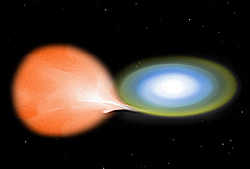
A nova is a transient astronomical event that causes the sudden appearance of a bright, apparently "new" star that slowly fades over weeks or months. Causes of the dramatic appearance of a nova vary, depending on the circumstances of the two progenitor stars. All observed novae involve white dwarfs in close binary systems. The main sub-classes of novae are classical novae, recurrent novae (RNe), and dwarf novae. They are all considered to be cataclysmic variable stars.
14 Herculis or 14 Her is the Flamsteed designation of a K-type main-sequence star 58.4 light-years away in the constellation Hercules. It is also known as HD 145675. Because of its apparent magnitude, the star cannot be seen with the naked eye. As of 2021, 14 Herculis is known to host two exoplanets in orbit around the star.

V1974 Cygni or Nova Cygni 1992 was a nova, visible to the naked eye, in the constellation Cygnus. It was discovered visually with 10×50 binoculars on February 19, 1992, by Peter Collins, an amateur astronomer living in Boulder, Colorado. At that time he first noticed it, it had an apparent magnitude of 7.2. Nine hours later he saw it again, and it had brightened by a full magnitude. For this discovery Collins was awarded the AAVSO Nova Award in 1993. The nova reached magnitude 4.4 at 22:00 UT on 22 February 1992. Images from the Palomar Sky Survey taken before the nova event showed identified a possible precursor which had photographic magnitudes of 18 and 17, but the identification of the precursor is not firm.

NQ Vulpeculae also known as Nova Vulpeculae 1976, was a nova that appeared in the constellation Vulpecula in 1976. It was discovered visually at 18:20 UT on October 21, 1976 by English amateur astronomer George Alcock. Its apparent magnitude at the time of discovery was 6.5 It reached its maximum brightness of magnitude 6.0 thirteen days after its discovery, at which point it may have been faintly visible to the naked eye. A few days after maximum brightness, it had faded to magnitude 8.3.
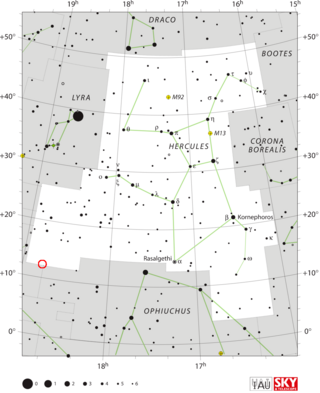
V838 Herculis, also known as Nova Herculis 1991, was a nova which occurred in the constellation Hercules in 1991. It was discovered by George Alcock of Yaxley, Cambridgeshire, England at 4:35 UT on the morning of 25 March 1991. He found it with 10×50 binoculars, and on that morning its apparent visual magnitude was 5. Palomar Sky Survey plates showed that before the outburst, the star was at photographic magnitude 20.6 and 18.25.
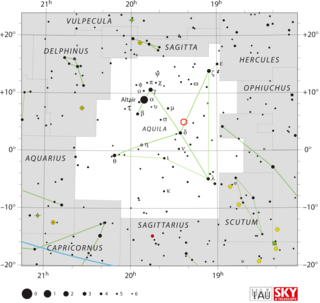
V1494 Aquilae or Nova Aquilae 1999 b was a nova which occurred during 1999 in the constellation Aquila and reached a brightness of magnitude 3.9 on 2 December 1999. making it easily visible to the naked eye. The nova was discovered with 14×100 binoculars by Alfredo Pereira of Cabo da Roca, Portugal at 18:50 UT on 1 December 1999, when it had a visual magnitude of 6.0.

V1280 Scorpii is the first of two novae that occurred in the constellation Scorpius during February 2007. Announced by the IAU in Electronic Telegram No. 835 and Circular No. 8803, the nova's magnitude was 9.6 when it was discovered on CCD images taken at 20:42 UT on 4 February 2007 by Yuji Nakamura of Kameyama, Mie, Japan. It was independently discovered on the same night at 20:30 UT by Yukio Sakurai of Mito, Ibaraki, Japan. It peaked at magnitude 3.79 on February 17, making it easily visible to the naked eye. V1280 Scorpii is two degrees south of M62.

14 Herculis b or 14 Her b is an exoplanet approximately 58.4 light-years away in the constellation of Hercules. The planet was found orbiting the star 14 Herculis, with a mass that would make the planet a Jovian planet roughly the same size as Jupiter but much more massive. It was discovered in July 1998 by the Geneva Extrasolar Planet Search team. The discovery was formally published in 2003. At the time of discovery it was the extrasolar planet with the longest orbital period, though longer-period planets have subsequently been discovered.
14 Herculis c or 14 Her c is an exoplanet approximately 58.4 light-years away in the constellation of Hercules. The planet was found orbiting the star 14 Herculis, with a mass that would make the planet a gas giant roughly the same size as Jupiter but much more massive. It was discovered on November 17, 2005 and published on November 2, 2006, although its existence was not confirmed until 2021.
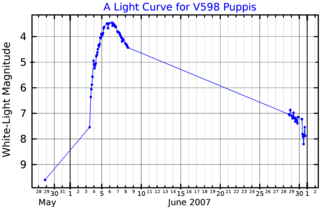
V598 Puppis is the name given to a nova in the Milky Way Galaxy. USNO-A2.0 0450-03360039, a catalog number for the star, was discovered to be much brighter than normal in X-ray emissions on October 9, 2007, by the European Space Agency's XMM-Newton telescope. The star was confirmed to be over 10 magnitudes, or 10,000 times, brighter than normal by the Magellan-Clay telescope Magellan-Clay telescope at Las Campanas Observatory in Chile. Pre-discovery images and identification of the progenitor would ultimately shows that the nova brightened from visual magnitude 16.6 to brighter than magnitude 4.

KT Eridani was a bright nova in the constellation Eridanus that produced an outburst in 2009. It was the first classical nova ever detected in that constellation. The nova was discovered at 12:52 UT on 25 November 2009 by K. Itagaki at Yamagata, Japan with a 21 cm patrol telescope. At the time of its discovery, it was a magnitude 8.1 object. The discovery occurred after the nova's peak brightness, but the All Sky Automated Survey system had detected the nova on three earlier occasions, allowing a more complete light curve to be produced. The peak magnitude, 5.4, was seen at 15:10 UT on 14 November 2009.

CK Vulpeculae is an object whose exact nature is unknown. It was once considered to be the oldest reliably-documented nova. It consists of a compact central object surrounded by a bipolar nebula.

V5856 Sagittarii, also known as Nova Sagittarii 2016 Number 4, was the 4th and brightest nova that occurred in the constellation Sagittarius during 2016. It was discovered by the All Sky Automated Survey for SuperNovae on 25.02 October 2016, at which time it had an apparent visual magnitude of 13.7. It was independently discovered by Yukio Sakurai of Mito, Ibaraki, Japan on 26.38 October 2016, by which time it had reached magnitude 10.4. It reached its peak brightness of magnitude 5.4, making it visible to the naked eye, on 8 November 2016. The nova occurred within a region of the sky monitored by the OGLE microlensing experiment, and that group reported that no star brighter than magnitude 22 was seen at the nova's position prior to its eruption.
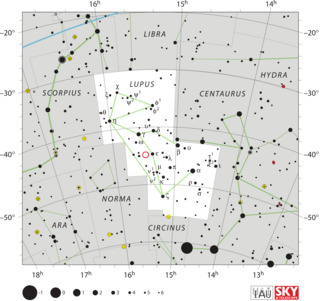
V407 Lupi, also known as Nova Lupi 2016, was a bright nova in the constellation Lupus discovered by All Sky Automated Survey for SuperNovae (ASAS-SN) on 24.00 September 2016. At the time of its discovery, it had an apparent visual magnitude of 9.1. The ASAS-SN team reported that no object at the nova's location brighter than magnitude 17.5 was seen on images taken four days earlier. Wildly incorrect coordinates were published in the announcement telegram, but corrected in a subsequent telegram. It reached a peak brightness of magnitude 5.6, faintly visible to the naked eye, on 25 September 2016.

V5668 Sagittarii, also known as Nova Sagittarii 2015 Number 2 was the second and brighter of two novae in the southern constellation of Sagittarius in 2015. It was discovered by John Seach of Chatsworth Island, New South Wales, Australia on 15 March 2015 with a DSLR patrol camera. At the time of discovery it was a 6th magnitude star. It peaked at magnitude of 4.32 on March 21, 2015, making it easily visible to the naked eye.
An Intermediate Luminosity Optical Transient (ILOT) is an astronomical object which undergoes an optically detectable explosive event with an absolute magnitude (M) brighter than a classical nova (M ~ -8) but fainter than that of a supernova (M ~ -17). That nine magnitude range corresponds to a factor of nearly 4000 in luminosity, so the ILOT class may include a wide variety of objects. The term ILOT first appeared in a 2009 paper discussing the nova-like event NGC 300 OT2008-1. As the term has gained more widespread use, it has begun to be applied to some objects like KjPn 8 and CK Vulpeculae for which no transient event has been observed, but which may have been dramatically affected by an ILOT event in the past. The number of ILOTs known is expected to increase substantially when the Vera C. Rubin Observatory becomes operational.
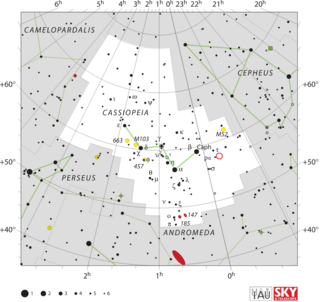
V705 Cassiopeiae, also known as Nova Cassiopeiae 1993 was a nova which erupted in the constellation Cassiopeia during 1993. The nova was discovered at 11:17 UT on 7 December 1993 by amateur astronomer Kazuyoshi Kanatsu of Matsue, Japan, who photographed it using a 35mm camera with a 55mm f/2.8 lens. Asteroid 6976 Kanatsu was named after him in honor of this discovery. At the time of its discovery the nova had a photographic magnitude of 6.5. Around 18 December 1993 it flared briefly to magnitude 5.3, and then it returned rapidly to magnitude 6.5. It underwent a series of smaller flares until mid February 1993, after which it began a precipitous decline in brightness.

FM Circini, also known as Nova Circini 2018, was a nova which appeared in the constellation Circinus in 2018. It was discovered by John Search of Chatsworth Island, New South Wales, Australia on 19.708 January 2018, using a DSLR with a 50 mm F/1.2 lens. At the time of its discovery, it had an apparent visual magnitude of 9.1. It was confirmed to be a nova spectroscopically on 21 January 2018. FM Circini reached a peak brightness of magnitude 5.8 on 22 March 2018, making it visible to the naked eye.

Nova Cassiopeiae 2021, also known V1405 Cassiopeiae, was a nova in the constellation Cassiopeia. It reached a peak brightness of magnitude 5.449 on May 9, 2021, making it visible to the naked eye. It was discovered by Japanese amateur astronomer Yuji Nakamura of Kameyama, Japan, at 10:10 UT on March 18, 2021. The nova was first seen by Nakamura in four 15 second CCD exposures with a 135mm F/4 lens, when it was at magnitude 9.3. Nothing was seen brighter than magnitude 13.0 with the same equipment in exposures taken at 10:12 UT on March 14, 2021. For the first seven months after discovery, the nova's brightness stayed at a rough plateau, fading and rebrightening at least eight times; it is considered a very slow nova. After the seven month long series of peaks, Nova Cassiopeiae began a linear decline in brightness. This nova has been detected throughout the electromagnetic spectrum, from radio to gamma rays.
















